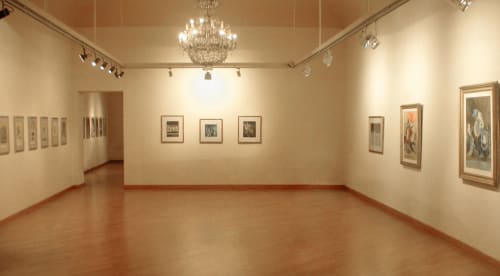The spotlights of Galleria d'Arte Maggiore g.a.m. turn on at 5:30 pm on Saturday 19 January on the mysterious and fascinating work of Graham Sutherland, an internationally renowned English artist who died in 1980 after having dedicated himself to various forms of art - from engraving to oil painting, from watercolor to the design of glass objects - and even distant themes - from the landscape to the illustration of printed texts, from religious painting to that of war scenes. Within such a rich production, the curators Franco and Roberta Calarota have selected a precise path that focuses on his activity as engraver and graphic artist, on oil and watercolor production and on the famous series of etchings dedicated to bees, so to offer to visitors a clear key to get in touch with a great master of contemporary art.
Graham Sutherland, born in London in 1903, belongs to that group of artists who began a critical re-examination of the historical avant-gardes of the early twentieth century, distancing themselves from both this type of research and the Informal art. The aim is to rediscover one's own identity as an artist within the European figurative culture and to re-appropriate the pictorial and figurative tradition, however, relating them to the reality of the contemporary political scene tragically marked by the Second World War.
In Sutherland's very first production, focused on the creation of prints of idyllic pastoral landscapes, it is possible to recognize a strong affinity with Samuel Palmer's research and therefore with the line of Neo-Romanticism and the English figurative tradition. However, starting from the 1930s, when he began to devote himself to oil painting, Sutherland replaced Palmer's serene visionary with a strong emotional intensity, deriving from the drama of William Blake, which led him to disintegrate the form of the subject and then reassemble it in hybrid assemblages characterized by the presence of anthropomorphic or vegetal features that come alive in a nocturnal, magical and disturbing atmosphere of an almost surrealist mold, so much so that in 1936 the artist exhibited at the International Surrealist Exhibition in London.
Subjects of this type also make their appearance in the 26 lithographs that make up the first bestiary created by the artist in 1968, a real visionary catalog of pure fantasy in which the subjects undergo strange processes of metamorphosis, and in that of 1979, created to illustrate the work of Apollinaire. These anthropomorphic interpretations do not appear in the microcosm of bees, published in 1977, which the Galleria d'Arte Maggiore proposes to offer to the public in its complete form by exhibiting the 14 etchings and aquatints on copper plates that make up the cycle.
Alongside this type of production, Sutherland carries out other types of research influenced above all by the terrible experience of the world conflict - from 1940 to 1945 he performed many official works as a "war artist" - and by the conversion to Catholicism that led him to produce starting from 1950s many works of a religious nature.
International fame came when the artist was still alive: in 1946 he exhibited for the first time in New York at Curt Valentin's Buchholz Gallery. In 1948 it was the turn of the Hanover Gallery in London and the Buchholz Gallery in New York. In 1952, on the occasion of his solo exhibition at the Venice Biennale, he visited Italy and the exhibition, expanded into a retrospective, was presented in the same year at the Musée National d'Art Moderne in Paris. Another retrospective, organized at the Arts Council of Great Britain in 1953, is exhibited at the Stedelijk Museum in Amsterdam, the Kunsthaus Zürich and the Tate Gallery in London. In 1959 he held a solo show in New York, organized by Paul Rosenberg and Co. Other exhibitions were set up in 1966 at the Marlborough Fine Art in London and in 1967 at the Wallraf-Richartz-Museum in Cologne and at the Gemeentemuseum in The Hague. Among the most important posthumous exhibitions we must certainly remember the one at the Tate Gallery in 1982 and at the Dulwich Picture Gallery in 2005.
